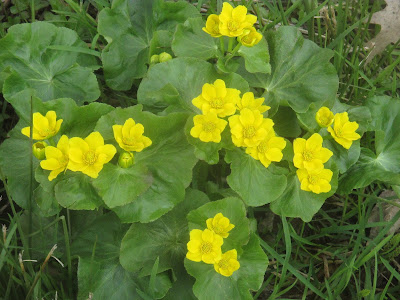 |
| MARSH MARIGOLDS... |
 |
| ...EVERY WET ROADSIDE DITCH AND SWAMP ARE FULL OF THEM |
 |
| JUNEBERRIES ARE JUST BEGINNING TO BLOOM |
I mentioned the marsh marigold, Calth palustris, a few days ago and since then they have popoped up everywhere in roadside ditches and swampy areas, more than I think I have ever seen before. Every spring is unique, favoring different blooming plants. This is one for the marsh marigolds.
A true harbinger of a northern spring are the Juneberries, one of the first noticeably decorative native trees to bloom. The Juneberries, or serviceberries (shadblow is their name out East, as they bloom about the time the shad run up the streams to spawn) are the most prominent of the northern native trees and shrubs to bloom in spring.
The most notably tree-like species, Amalanchier arboreum, in the Rose Family, haa suddenly popped into bloom in city and countryside. There are a number of shrubby Juneberries as well, both wild and cultivated, most of which are quite similar in bloom, but the truly tree-like are usually arboreum, as well as the hybrid grandifloria of the nursery trade
The delicate flowers of Juneberries only last a few days, especially if the weather turns warm. Many of the species interbreed, and are difficult to sort out, so visit the Freckman Herbarium web site, University of Wisconsin Stevens Point, for a list of Wisconsin species. My recorded blooming dates for the genus in the Bayfield area are 5/09/16; 5/07;15; 5/27/13; 4/19/12; 5/20/11; 5/25/08. Not very consistent. I should have picked one specific tree and followed it. In general, Mother's Day is about on average, and I think I can say that, as a native genus, Amelancheirs only bloom when there is very little chance of frost left.
Soon the wild cherries will also flower, and from a distance they all rather blend together in the landscape. But the Juneberries are the first, and I think they are as significant in the northern landscape as the flowering dogwoods are in the southern and eastern US. They will be loaded with red to black apple-like fruits about the size of a large pea that are very good to eat if you can get to them before the birds, bears and the other critters. In fact, Juneberry trees are best not planted where bears are likely to find them, as the bears will simply swat down a young tree to get at the ripe fruits.
If you wish to plant a Juneberry tree, either obtain a good tree form from a reliable northern nursery or find a wild sapling growing near a tree form mother tree; they should get full sun to be at their best, but as woods edge and understory plants they will tolerate quite a bit of shade. A good woodland loam is best for soil, nut they will tolerate less desirable soils. Adequate moisture and decent drainage are a plus. Be sure to mulch them, as they are woodland trees.











No comments:
Post a Comment